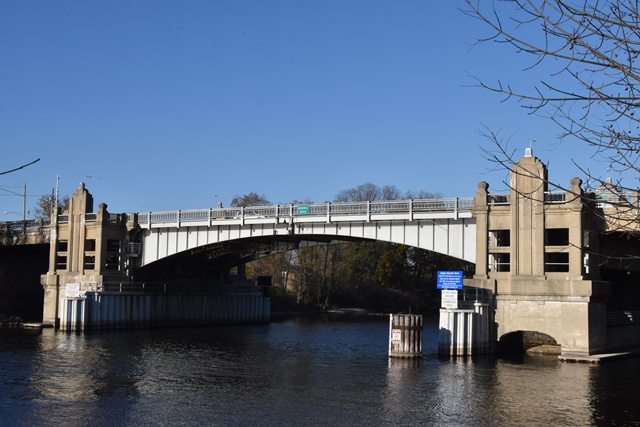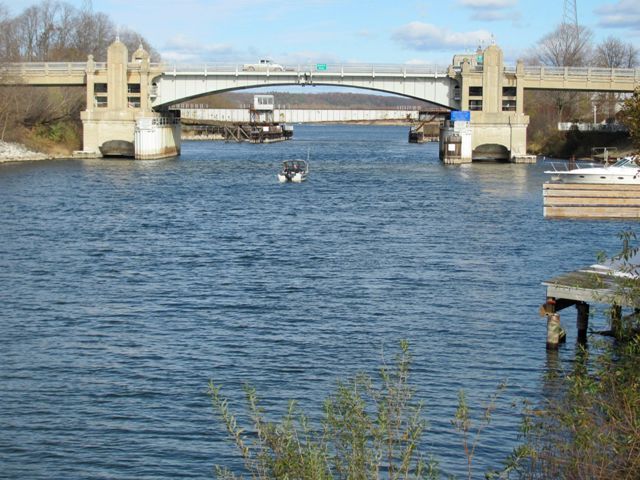We Recommend:
Bach Steel - Experts at historic truss bridge restoration.
BridgeHunter.com Phase 1 is released to the public! - Visit Now
Memorial Bridge
US-31 Manistee Bridge

Primary Photographer(s): Nathan Holth
Bridge Documented: November 6, 2010 and October 29, 2022
US-31 (Cleveland Street / Cypress Street) Over Manistee River
Manistee: Manistee County, Michigan: United States
Metal Variable Depth Deck Girder, Movable: Double Leaf Bascule (Rolling Lift) and Approach Spans: Metal Stringer (Multi-Beam), Fixed
1933 By Builder/Contractor: Strom Construction Company and Engineer/Design: Scherzer Rolling Lift Bridge Company of Chicago, Illinois
2005
133.0 Feet (40.5 Meters)
316.0 Feet (96.3 Meters)
40 Feet (12.19 Meters)
1 Main Span(s) and 2 Approach Span(s)
51151011000B010

View Information About HSR Ratings
Bridge Documentation
Additional Notes: The road this bridge carries is described as Smith Street on the original plans.
View Archived National Bridge Inventory Report - Has Additional Details and Evaluation
This handsome bridge is perhaps the most extensively decorated bascule bridge in Michigan. The bridge has massive concrete bascule piers that are beautifully adorned with architectural treatment that follows an Art Deco type of design. An early appearance of Michigan's signature type R4 railings are present on this bridge, further enhancing the aesthetic qualities of the bridge. The R4 design was used extensively on the bridge, and even adapted for some non-standard uses such as for a gate to block off access to the bridgetender building and other areas.
The bridge is a relatively large structure, partially on account of approach spans leading up to the double-leaf bascule span. The bridge is noteworthy as an excellent example of a rolling lift bascule bridge that was designed by Scherzer Rolling Lift Bridge Company, which was a leader (and innovator) in rolling lift bascule design. Scherzer and the rolling lift bascule bridge was a competitor to the trunnion bascule bridge, championed by rival engineer Joseph Strauss.
The approach spans on this bridge include steel stringers with outer (fascia) beams encased in concrete and metal diaphragms with circular cutouts. This, combined with the R4 railings in place, make for spans that are detailed very similarly to the Berry Road Bridge. Like the Berry Road Bridge, this bascule bridge is one of the earliest bridges to be built using Michigan's type R4 railing, which was first used in 1932, which explains why there are these design similarities. These characteristics of the approach spans, as well as the early use of the R4 railing add to the significance of the bridge. Indeed, with nearly all examples of 1932 stringer bridges in Michigan having been demolished, the approach spans of this bridge alone might be considered individually historic.
The bridge has been the recipient of a nicely designed rehabilitation that prolonged the life of the bridge but also was very respectful of the historic integrity of the bridge. Although crash-tested metal tube guardrails were added to the bridge, the original R4 railing panels were retained, and the concrete railing posts retain the correct architectural details. Thanks to these efforts, the bridge today retains excellent historic integrity, despite the rehabilitation.
Above: Historical Postcard of Bridge
Source: Donald Harrison, http://www.flickr.com/photos/upnorthmemories/2813627657/, CC BY-NC-ND 2.0
This bridge is tagged with the following special condition(s): Unorganized Photos
![]()
Photo Galleries and Videos: Memorial Bridge
Bridge Photo-Documentation
Original / Full Size PhotosA collection of overview and detail photos. This gallery offers photos in the highest available resolution and file size in a touch-friendly popup viewer.
Alternatively, Browse Without Using Viewer
![]()
Bridge Photo-Documentation
Mobile Optimized PhotosA collection of overview and detail photos. This gallery features data-friendly, fast-loading photos in a touch-friendly popup viewer.
Alternatively, Browse Without Using Viewer
![]()
Additional Unorganized Photos
Original / Full Size PhotosA supplemental collection of photos that are from additional visit(s) to the bridge and have not been organized or captioned. This gallery offers photos in the highest available resolution and file size in a touch-friendly popup viewer.
Alternatively, Browse Without Using Viewer
![]()
Additional Unorganized Photos
Mobile Optimized PhotosA supplemental collection of photos that are from additional visit(s) to the bridge and have not been organized or captioned. This gallery features data-friendly, fast-loading photos in a touch-friendly popup viewer.
Alternatively, Browse Without Using Viewer
![]()
Maps and Links: Memorial Bridge
Coordinates (Latitude, Longitude):
Search For Additional Bridge Listings:
Bridgehunter.com: View listed bridges within 0.5 miles (0.8 kilometers) of this bridge.
Bridgehunter.com: View listed bridges within 10 miles (16 kilometers) of this bridge.
Additional Maps:
Google Streetview (If Available)
GeoHack (Additional Links and Coordinates)
Apple Maps (Via DuckDuckGo Search)
Apple Maps (Apple devices only)
Android: Open Location In Your Map or GPS App
Flickr Gallery (Find Nearby Photos)
Wikimedia Commons (Find Nearby Photos)
Directions Via Sygic For Android
Directions Via Sygic For iOS and Android Dolphin Browser
USGS National Map (United States Only)
Historical USGS Topo Maps (United States Only)
Historic Aerials (United States Only)
CalTopo Maps (United States Only)





